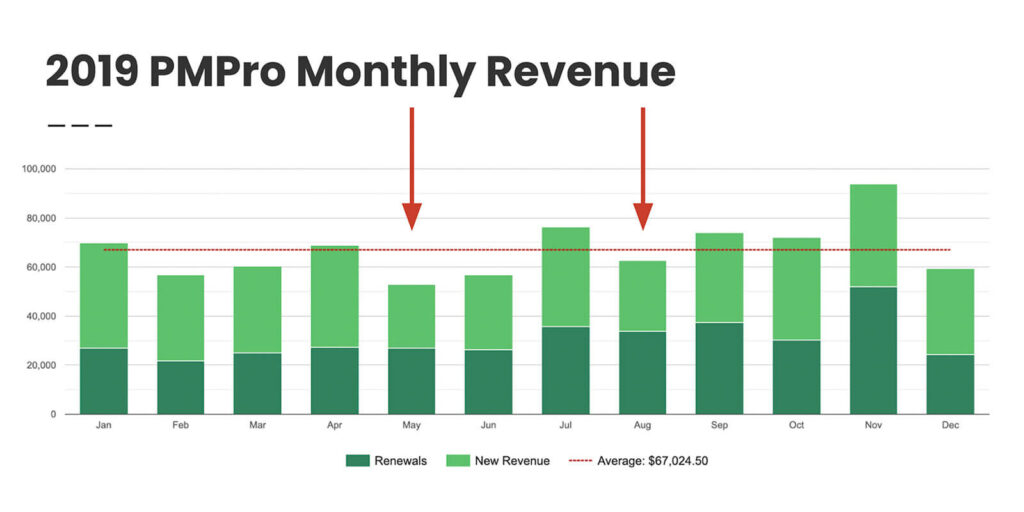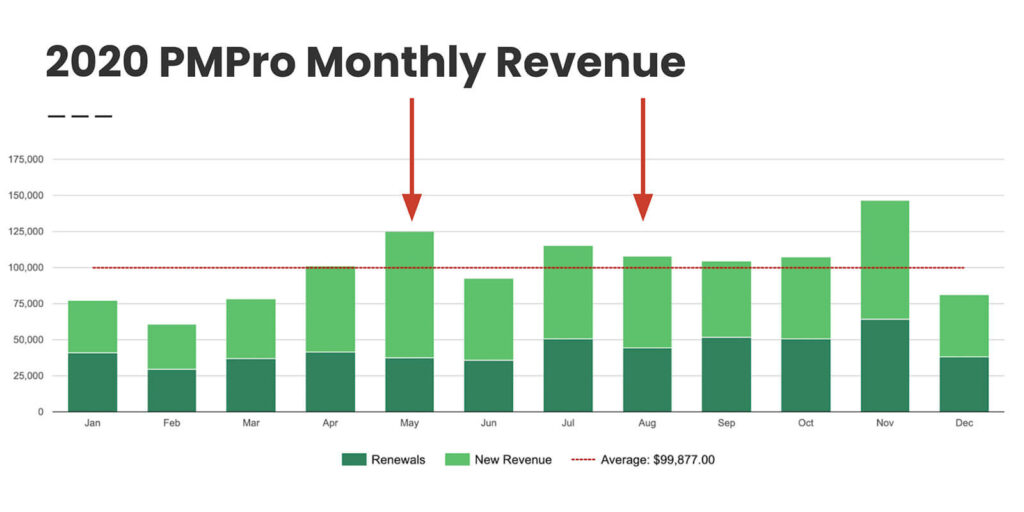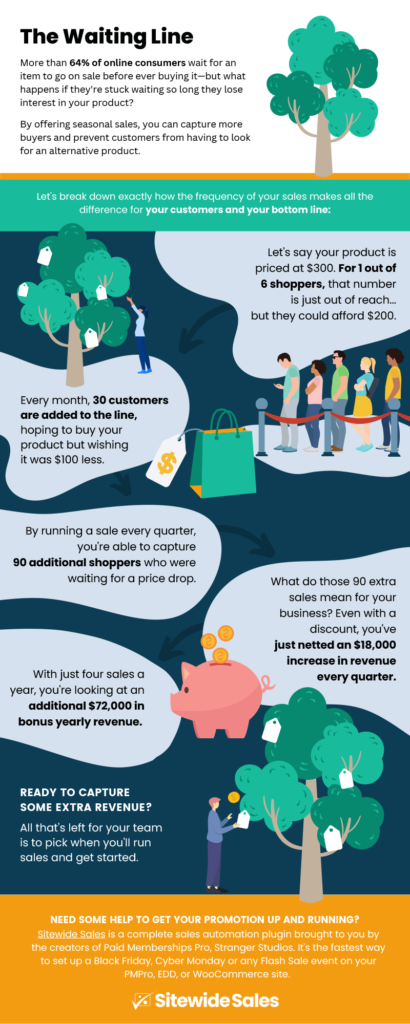Your eCommerce platform and tools like Sitewide Sales make it easy to run sales on your WordPress site. So how do you know when you should be running sales—how do you plan your annual sale calendar?
Tell me if any of these scenarios have you nodding your head “YES!”
- You’re running sales because it’s the end of the month and you need some extra cash.
- You run sales because you peeked on a competitor’s site and saw that THEY had a sale running.
- You are launching a new product and thought “why not run a sale on my old thing to move a few more units?”
None of these strategies are an inherently bad approach. But each of these flash sale strategies have a key flaw: they are reactive, not proactive.
In this guide, I want to break down my strategy for running seasonal sales with intention by designing a year-long sale calendar. Follow these steps to have a clear idea of:
- When you’ll run sales in the year ahead.
- What promotion you will offer.
- And, have all of these sales ready to send so all of you have to do is sit back and watch the revenue stream in.
Only Running Sales on Black Friday?
Black Friday only comes once a year. And during that time everyone else is running sales. As an online business, you are facing a customer base that is highly distracted.
If you sell to B2B customers, you are not only fighting the other merchants for their eyeballs, you’re also probably trying to get attention from a buyer that is busily running their own business’ flash sale that weekend.
For this reason, I often recommend your Black Friday/Cyber Monday (BFCM ) deal to be the best offer you have all year. You have to give an insane discount to reach anyone outside your most loyal customer base.
For my subscription product, we run between three and four sales per year, in addition to our standing BFCM event. While I’d have assumed that would impact the performance at Black Friday, it hasn’t.
- Each week-long sale brings in about $20,000 in bonus money. Black Friday being the best sale of the year which made $34,000 in 2021.
- As a subscription product, we create more even revenue across the year by strategically running sales in the lower average revenue months.
- And if you’re running an eCommerce site with a diverse product line, what I’m about to teach you becomes even more exciting… and more lucrative.
So when are the OTHER natural periods to run sales for YOUR business?
A New Strategy For Planning Flash Sales
Earlier I talked about a few reactive strategies you may already be using to decide when to run a sale:
- Competition
- Inventory
- Cashflow
Here’s a proactive sale strategy that has been our subscription product’s most lucrative lesson: the waiting line.
When you’re planning your annual sale calendar, the pace you run sales has to match your customer buying patterns AND the growth of your list.
Close your eyes and picture your online subscription business as a bricks and mortar shop. You’re standing at your favorite small shop in town and you’re right outside the door.
The store is open for business, but you cannot go inside.
You checked your wallet, dug around in the sofa cushions, and maybe even peeked in your roommate’s top drawer, but you only have $8 in your pocket.
And everything in the store is $10.
But you actually really want to buy something, so you keep waiting in line outside the shop. In a few minutes, you turn around and see that a few more people have joined you. They are all queueing up behind you in the waiting line.
After a few hours, you look back and see that the line is now ridiculously long.
Your Online Store Has a Waiting Line
Your online business has a waiting line just like this.
Every time someone visits your site, joins your email list, follows you on social media, makes a lower price purchase, some number of them start waiting in line.
Businesses that run a single sale every year on Black Friday ignore the ever-growing queue of people waiting to buy.
- Some of these potential customers end up standing in line for a really long time. As long as 361 days in a year.
- Some of these potential customers get sick of waiting. They abandon the line and go shop elsewhere.
Should you even care about these people? You might be thinking “Forget about them. If they aren’t willing to pay full price for my product, I don’t want them as a customer.”
But while price is sometimes the actual barrier to conversion, other times it’s because some people LOVE coupons. In fact, research has proven that people are HAPPIER when they get a deal.
The scientific research shows that oxytocin, a hormone that is directly related to love and happiness, spikes when people receive a coupon, and, in fact, increases more than when people receive a gift.
—Scientific Study Shows Coupons Can Help Take the Stress out of Holiday Shopping
Who are you to deny someone happiness?
How Paid Memberships Pro Plans Quarterly Sales
In addition to our Sitewide Sales plugin for flash sales, we also have a membership plugin called Paid Memberships Pro.
Aside from experiments, we stick to a revenue-regulating sales strategy when planning our annual sales calendar. This strategy, coupled with analyzing the length of our waiting line, means that we have more successful, more reliable sales.
Here’s how it works: At the start of 2020 we looked back at the 2019 revenue chart. We looked at the months where monthly revenue was below the average line. In this case, we chose to run sales in May and August of 2020.

Subscription products may also want to consider scheduling sales to even out months where new sales is a smaller percentage of total revenue. For recurring memberships, the sale you run this year has a cumulative effect for all following years, until the member churns.
The more you can do to increase new sales in one month, the better that month will be in the years ahead.
In 2020, we ran a sale in May and August. You can see in the full chart of our 2020 revenue that May and August are now above the average line. Exactly what you should see happen with this strategy.

How to Design an Annual Sale Calendar
When we design sales for my product, we are super focused on the waiting line.
If we run too many sales, there aren’t enough people waiting to buy because the line is too short. Sometimes there can be a lot of people in the line, but you know that not every single one of them will convert.
So you have to wait for the list to build up, then run the sale.
List Growth Rate and Sale Timing
Start by analyzing your list growth rate and customer buying patterns. This first step helps you determine how frequently you should be running sales (how many sales per year).
First, run a single random sale that isn’t your BFCM weekend sale. What percentage of your list converts? This step is especially important for subscription products that do not have a clear path for upsells or repeat purchases.
- How big will your list be in three months? In five months?
- Will enough new people have joined your list in that time to make it worth running the sale?
For some napkin math, let’s say you acquire about 30 line waiters (cool leads) per day. Your product regularly costs $100 but you will put it on sale for $70.
If you wait 3 months between running flash sales, there will be 2,700 new leads in your waiting line.
- If you convert 1% of the line waiters = 27 purchases ($1,890 bonus revenue).
- If you convert 10% of the line waiters = 270 purchases ($18,900 bonus revenue).
Do your own math. Is it worth running a quarterly sale based on these numbers?
Time Between Purchases
For physical products that do have repeat purchases: also try to figure out the average period of time between that repeat purchase. In addition to list growth, you also need to know how often your current customers are eager to buy more from you.
This metric is called Time Between Purchases (TBP). I’m not a person that needs exact metrics for my business, so this can be a rough guess / gut calculation. For those that want the real value, do the math:
365 / Purchase Frequency = Time Between Purchases
Purchase frequency here is the average number of times a unique customer purchases from you in a single year.
You should now have a rough idea of how many sales per year you want to run. For us, that number is between 3 and 4 sales.
The next step is to choose the exact sale dates for the year ahead. The strategies here vary depending on a few factors:
- What market you’re in,
- Whether your product is a subscription or one-time purchase, and
- Especially whether your product has repeat purchases or is more “once and done”
Revenue-Regulating Sale Strategy
In this strategy, you design the sale calendar with the goal of creating more even revenue across the year. Why is this helpful? More regular revenue reduces the owner’s need to maintain a gigantic runway. You’ll also have a more predictable budget, because it really stinks to manage a business which makes $50,000 in one month and $10,000 the next.
So pull up your revenue chart from the last full calendar year. Where are some dips?
Make a note of a few months in the year that would be nice to boost revenue. You can also look at the year ahead and choose some months that would be nice to have some extra cash on hand. Maybe you have a big team retreat planned, Maybe you have a new product to invest in. Or maybe there’s a big invoice coming due for new inventory.
Running Sales With Seasonal Products
One final sale planning strategy to cover here is product seasonality. For many eCommerce sites, there is a natural seasonality to product sales and buyer behaviors.
I want you to think about your product. If you sell a wide variety of products, you can do this exercise for each category of product you are considering to run sales for.
- Do people generally buy your product for “back to school”?
- Are your products geared toward a “New Year, New You” transformation?
- Is your product something we’re all hunting for when the weather starts to get warmer… or colder?
When you find a good seasonal matchup, you eliminate a huge piece of complexity when running sales. Don’t run sales outside the “season”. If people aren’t in the mood for your product, chances are your sale will be a flop.
Plus, a large piece of running sales that I hear from eCommerce site owners is in designing an interesting offer with creative sales copy and sales creatives.
Run sales when you can match product seasonality with the actual season. This strategy gives you a built-in theme that can be used across all aspects of your sale’s design.
I highly support anything you can do to make running a sale easier for you as the admin.
Recap: Design Your Annual Sale Calendar
There are four main ways to plan an annual sale calendar. In practice, your eCommerce site uses a combination of these strategies to run successful sales.
To recap, here are the four strategies you can use to plan your annual sales calendar:
- List Growth Rate and Sale Timing
- Time Between Purchases
- Revenue-Regulating Sale Strategy
- Running Sales With Seasonal Products
Use these strategies next year to run sales more confidently for your eCommerce site.
Run Better Sales with Sitewide Sales
Sitewide Sales is a new way to run sales for your WordPress-powered eCommerce site. Our plugin helps you set up an active promotion that runs from your set start time and end time—no more lost sleep waiting to hit “start”.
Use SWS with your favorite WordPress eCommerce plugins to handle the banners, landing pages, discount code rules, and performance reporting.




